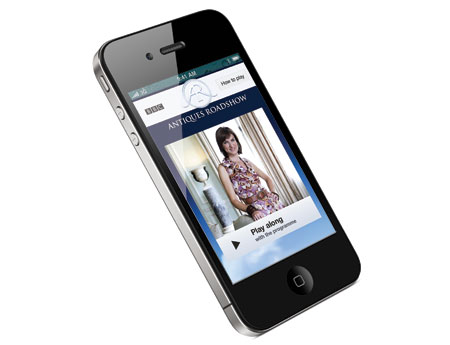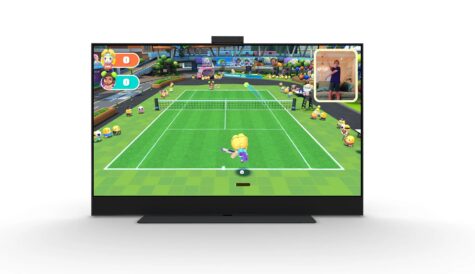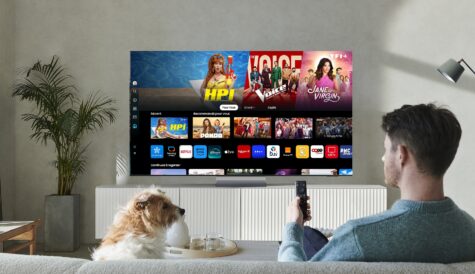Good companions – how apps are becoming integral to TV
 Broadcasters and service providers want to keep viewers’ attention as they interact with second screens. Adrian Pennington looks at how they are making apps integral to the TV experience.
Broadcasters and service providers want to keep viewers’ attention as they interact with second screens. Adrian Pennington looks at how they are making apps integral to the TV experience.
The perennial battle to own the consumer is being extended into companion applications, with stakeholders jockeying for position to retain the attention of the consumer. That’s because viewers are shifting from passivity in front of their TV sets to a state where they exercise greater control over viewing habits by multi-tasking on smartphones and tablets.
Net-enabled devices are taking a central role in the TV experience, not only for watching TV, but also to control its functions and to provide discovery and contextual information about content. The challenge faced by broadcaster, service operator and even content producer is to avoid viewers treating broadcast TV like radio – with their eyeballs only on the second screen – and to keep them attracted to their content or within their service.
Show formats
Naturally, there are strategies for achieving this. Nangu.TV’s CEO Antonin Kral, for one, believes that comfort is the biggest driver: “If you can easily find the content you are looking for through the service you are paying for, then you have no need to go searching for it elsewhere,” he says.
The most common companion experiences to date have been around show formats – talent shows or quizzes such as the BBC’s inaugural second screen app for The Antiques Roadshow. While these continue to proliferate there has been a recent shift. “There is clear interest among broadcasters who have noted the success of format specific apps and would like to now drive engagement around all of their programming, and channels, and to do so theoretically as often as people are viewing TV,” says Alex Terpstra, CEO of content security and identification specialist Civolution.
French media group Lagardère Active, for example, is using Civolution’s synchronisation technology to drive second screening around family channel Gulli. “If you develop a TV format or series without any notion of second screen you are already in a danger zone,” says Terpstra. “You can’t afford to not address the opportunities that already exist.”
Tom McDonnell, founder/director at second screen app creator Monterosa, has also “seen a big shift in the last year where most broadcasters are now treating synchronous second screen experiences as something they should provide where appropriate. Some are doing this to activate audiences and increase sharing and discovery. Some are doing it because sponsors and advertisers are demanding it.”
Zeebox, the second screen app provider that launched with investment from broadcasters in the UK (BSkyB), US (Comcast, NBC Universal) and Australia (Network 10), says content teams are exploring ways to enhance shows on Zeebox. “If you want to pitch a new commission to Sky you need a second screen proposition around it or you will be sent back to come up with something,” says co-founder Anthony Rose.
Michael Woodley, business development consultant at watermarking specialist Intrasonics, reports that broadcasters want to take complete ownership of synchronisation technology “and make it part of their standard infrastructure.” From Woodley’s point of view the secret to second screening is to make the app relevant to what’s on the first screen “but not so distracting that viewer’s eyeballs are constantly on the second screen,” he says. Intrasonics’ development of The Antiques Roadshow app ensured that attention was only demanded of the viewer at intervals and for a few seconds (in order to input an estimate value of a show item).
“At the broadcaster level, second screen interaction is about content engagement, whereas for platform operators the keys are primarily around content discovery and recommendation,” says Tom Cape, CEO at app developer Capablue.
For Michael Lantz, CEO of TV app store technology provider Accedo, the primary use cases for second screen interaction are discovery – using the companion as a better way to browse and search through vast amounts of content; control – using a device to control the first screen (i.e swipe to view); and enhanced information about a specific programme which is playing or about to play on the first screen. “Social TV doesn’t even rate in my top three,” he says.
Social dimension
For Steve Plunkett, chief technology officer, Red Bee Media, on the other hand, social is an important aspect of the companion experience, but also just one among many. “The social conversation is taking place anyway so the challenge is to augment that in some way,” he says. “This can include integration of a social stream – i.e Twitter – within a broadcast second screen experience but ideally it should go beyond that by providing something extra, such as live contribution from show producers and talent. Additional activities, such as social sharing, should also include user/community sharing of likes, recommendations and related content.”
Kral links the appeal of second screen social interaction with privacy. “Users are less willing to show their social media pages in the living room and as such they turn to their second device to access them,” he says. “Our second screen solutions are tailored so that users can access and report to these sites quite easily from the Nangu.TV platform.” [icitspot id=”46492″ template=”box-story”]
McDonnell questions whether social TV interaction needs to involve an established social network. “If service providers want to monetise a second screen audience they must remain in control of the digital environment and actively create something special and meaningful that’s accessible instantly by the majority of their audience,” he says. “It’s dangerous to assume everyone uses a specific social network, or that they want to expose their actions to their friends.”
Take Monterosa’s Top Gear Bingo. Just launched with BBC Worldwide, it is mainly a promotional ‘event’ online and on mobile web, taking place during new transmissions of the show, and is intended to create an immersive interaction with a variety of advertising opportunities for sponsors.
“Facebook and Twitter usage is optional, so we’re not alienating people who want to play on their own,” explains McDonnell. “You’d be surprised how many people enjoy interacting with TV on their own. Despite high levels of multi-tasking, TV audiences are rarely where you want them at the time you want them on the second screen. If they happen to be connected while watching TV, they’re distracted.”
For Monterosa the solution is simple. “TV has all the attention, so if the broadcaster promotes something cool on the second screen during airtime it will get high levels of adoption,” says McDonnell. “If you don’t use TV to promote the second screen, you will get low adoption. This is why broadcasters, not independent app-builders, will win the battle for the second screen. Remember, the majority of people are still sitting there watching TV and they need pushing, reminding, coercing into getting interactive on their device.”
Intrasonics cites an application by Spain’s Antena 3 in which a vision mixer was able to insert watermarked triggers into a live chat show to coincide with specific guests – for example guest bios and movie trailers in parallel with the featured interviewee popping up on tablets. “This succeeded because the broadcaster put their brand behind the app and created it for the whole channel – for interactivity during live shows and also dramas, and murder-mysteries. They promoted it heavily and achieved over 600,000 downloads of the app in two months,” says Woodley.
Relevant and personal
Social TV is only as effective as it is relevant and personal, suggests technology provider Tvinci’s co-founder, Ido Wiesenberg. “Social interactions on the [second screen] are only valuable if they relate to the TV service, so as long as all activity relating to a consumer’s video consumption occurs on the OTT video platform, and as a result the video service is used as the main domain for content discovery, a service provider need not view external social networking sites as a threat.”
Tvinci offers customers the ability to manage each household as a collection of individuals, where each can have their own sub-account with the relevant social feeds. This allows Tvinci customers to offer personalised recommendations based on friends’ activities. Wiesenberg points out that service providers can offer incentives to use these tools from within the environment, for example, campaigns which grant credits of gifts based on activities performed within the service.
“People love to use second screens as a remote and as a programme guide but neither is inherently viral,” says Rose. “What is viral is commenting around a show. So there are at least two different consumer propositions – for what’s on TV and for information contextualised about programming, which includes the ability to chat with friends. We’ve a product that does both, whereas other applications offer one or the other.” In any case, the problem may be less acute in Europe than in the US, where a myriad of third party social TV apps compete that have less traction here – such as GetGlue, Viggle and Miso.
“Ultimately, the winning formula will blend both open social networks and curated recommendation engines in a seamless content discovery tool,” says Milya Timergaleyeva, vice-president, market strategy, at middleware provider Oregan Networks. “The challenge faced by operators is in ensuring that the service enriches the experience, without cramming the screen full of icons and information or infringing on privacy.”
Since, on a second screen, the internet will be just a click away, should operators embrace the wider web rather than struggle against it? “Linking to the open internet is best done to relevant and contextual applications that make sense from a user experience point of view,” says Lantz. “This will provide an attractive middle ground, as long as the service providers are reasonably open about which apps are allowed onto the platforms.”
To maximise reach, service providers could syndicate or openly publish their contributions for third party application consumption, which will introduce powerful network effects, advises Plunkett, adding that they “may prefer to retain an element of exclusivity” so that they provide the destination of choice to the audience. “In reality they will likely need to do both depending on the context and their specific objectives for a show.”
Technical challenges
Developers are starting to think about a second screen response to the user’s location. “If I’m at home then I want my TV to link closely with companion services and when away from home I would like the ability to remote record, plan, stream VOD,” says Cape. “So there are very different use cases. The question is whether you have two different apps for in home and VOD away from home, or do you get clever and create one app that achieves both? To my mind that’s the way forward.”
“As long as all activity…occurs on the OTT video platform…a service provider need not view external social networking sites as a a threat.” Ido Wiesenberg, Tvinci
In this TV everywhere scenario, a seamless and secure experience in or out of the home go hand in glove. There are video delivery challenges: delivering optimal quality and bandwidth to a given device in a given place at a given moment in time; content protection challenges – both strong encryption and DRM with device and user level entitlement; and the scaling challenges that go with both.
“When moving from in and out of the home, the system should recognise through IP identification that the user is in an ‘off net’ environment, and request the stream from the CDN as opposed to the close managed IPTV network,” says Weisenberg.
“There are plenty of solutions in the market which enable this switch. However the backend system will need to first of all recognise where the user has dropped off the stream from within the house to continue from the same stream off-net, in addition to in some cases requesting a licence from an alternative DRM provider.”
Tvinci is currently implementing such a complex solution where the IPTV stream is protected by Marlin and out of the house transfers to Widevine/Playready.
Synchronised opportunities
For Timergaleyeva, out-of-the-home live and recorded content viewing is introducing a need for studios to revisit content rights management in a multi-screen context. “Currently accepted scenarios involve costly, multi-tuner devices with high storage capacity, an approach which clearly has its commercial drawbacks, as well as not catering for the scenarios when the home device is not present on the network,” she says.
“In the long term, inability to record and stream from the cloud without the need to link to the home set-top will limit the value of the second screen app.”
Synchronisation techniques are being deployed by advertisers to counter the threat of viewers choosing to interact with second screens rather than watch spot ads – although such behaviour was ever thus; we just used to go make a cuppa when the ad break was on.
“It’s logical that people will do something else other than watch ads during the commercial break – and it’s a trend you can’t fight,” says Terpstra. “If we are all multitasking on a second screen the idea is that you can help advertisers bring the ad message to the second screen experience simultaneous to the airing of the ad on TV.”
The second screen’s clear advantage over the TV in lean forward interactivity theoretically also means that advertisers can better convert sales through direct calls to action and initiatives like product placement. There is no surprise in the mushrooming of solutions designed to show users targeted advertisements simultaneously with specific TV programmes and commercials.
Zeebox’s SpotSync adverts will appear in the live stream area of the Zeebox app and also give users a number of expandable panels and tags related to what’s happening in the TV show. For traditional spot adverts, they will appear for the same duration but then retract to a clickable tag, allowing users to find and interact with it later.
In the UK, Sky Media has exclusive sales rights to SpotSync. Although Rose can claim that Zeebox is no disruptor, allowing incumbents to reach audiences on multi-screens and develop new business models, where Zeebox doesn’t have a broadcaster relationship he admits “we may sell ads on channels direct with brands.”
Civolution has tied its SyncNow technology with that of ad-management and distribution platform DG to trigger TV synchronised advertisements. Capablue has trialled similar automatic watermarking technology to sync with Channel 4’s linear output.
“Our proof of concept encourages the viewer to interact with a brand by delivering a much more sophisticated advertising experience that pushes content straight to the consumer in a non-intrusive way,” says Cape.
ITV enjoys an exclusive UK deal with Shazam, which adapted its audio-recognition technology to enable viewers of commercials to receive additional content or click-to-purchase. Since their launch during the final of Britain’s Got Talent last May, Shazam-enabled ads have delivered over £700,000 (e800,000) to the bottom line. The relationship has since been extended to augment content around live programming, the first application for which was in support of The Brit Awards.
Explaining the difference between Shazam and C4/Capablue’s concept, Cape says: “With our applications the experience is sit-back, whereas with Shazam the user has to actively download and use the app. Why does Shazam need ITV? Effectively, they own the customer engagement and they could go direct to brands and agencies.”
Wiesenberg suggests that during 2013 we will see more service providers offering e-commerce as part of video consumption. “If you have viewed a certain product on an actor you admire, perhaps you would like to purchase it, for example. Purchasing through context provides added value both for the service provider, and for the user.”
For McDonnell, the greatest commercial challenges are around creating audience propositions which can be sold to advertisers without highly skilled sales staff. “It still takes a lot of learning and effort to sell into agencies, so companies like Monterosa have to work harder to make our propositions easier for our broadcast and agency clients to sell to their brands,” he says.



